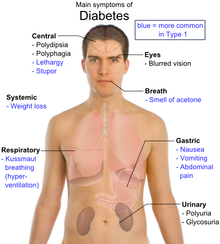 What is diabetes mellitus?
What is diabetes mellitus?
Diabetes is a disease of the pancreas, an organ behind your stomach that produces the hormone insulin. Insulin helps the body use food(glucose) for energy. When a person has diabetes, the pancreas either cannot produce enough insulin, or the body uses the insulin incorrectly, or both. Insulin works together with glucose in the bloodstream to help it enter the body’s cells to be burned for energy. If the insulin isn’t functioning properly, glucose cannot enter the cells. This causes glucose levels in the blood to rise, creating a condition of high blood sugar or hyperglycaemia which is the hallmark of diabetes, and leaving the cells without fuel. When blood glucose rises above a certain level, it spills over into the urine.
What are the common types of diabetes?
There are two common forms of diabetes: type 1 and type 2.
- Type 1(Insulin dependent): Type 1 diabetes occurs because the insulin-producing cells of the pancreas are damaged. In type 1 diabetes, the pancreas makes little or no insulin, so sugar cannot get into the body’s cells for use as energy. People with type 1 diabetes must use insulin injections to control their blood glucose. Type 1 is the most common form of diabetes in people under age 20, but it can occur at any age. Ten percent of people with diabetes are diagnosed with type 1.
- Type 2(Non-insulin dependent): In type 2 diabetes, the pancreas makes insulin, but it either doesn’t produce enough insulin or the insulin does not work properly. Type 2 diabetes may sometimes be controlled with a combination of diet, weight management and exercise. However, treatment also may include oral glucose-lowering medications or insulin injections.
Generally, type 2 diabetes is more common in people over age 40 who are overweight. However, the increased prevalence of obesity has increased the number of people under age 40 who are diagnosed with type 2 diabetes. Nine out of 10 people with diabetes have type 2.
What causes Diabetes Mellitus?
The following factors may increase your chance of getting diabetes:
- Family history of diabetes or inherited tendency
- African-American, Hispanic or Native American race or ethnic background
- Obesity (being 20 percent or more over your desired body weight)
- Physical stress (such as surgery or illness)
- Use of certain medications
- Injury to pancreas (such as infection, tumor, surgery or accident)
- Autoimmune disease
- Hypertension
- Abnormal blood cholesterol or triglyceride levels
- Age (risk increases with age)
- Alcohol (risk increases with years of heavy alcohol use)
- Smoking
- Pregnancy (Pregnancy puts extra stress on a woman’s body which causes some women to develop diabetes. Blood sugar levels often return to normal after childbirth. Yet, women who develop diabetes during pregnancy have an increased chance of developing diabetes later in life.)
How is diabetes diagnosed?
The preferred method of diagnosing diabetes is the fasting blood sugar test (FBS). The FBS measures your blood glucose level after you have fasted (not eaten anything) for 10 to 12 hours.
Normal fasting blood glucose is between 70 and 100 mg/dl for people who do not have diabetes. The standard diagnosis of diabetes is made when:
- A patient has a fasting blood glucose level of 126 mg/dl or higher on two separate occasions; or
- A patient has a random blood glucose level of 200 mg/dl or greater and has common symptoms of diabetes, such as:
– Increased thirst
–Frequent urination
–Increased hunger
–Fatigue
–Blurred vision
–Weight loss - On occasion, an oral glucose tolerance test may aid in the diagnosis of diabetes or an earlier abnormality that may become diabetes – called impaired glucose tolerance.

- Slow healing sores or cuts
- Itchy skin (usually in the vaginal or groin area); yeast infections
- Dry mouth
What are some of the long-term complications of diabetes?
Retinopathy (eye disease): All patients with diabetes should see an ophthalmologist (eye specialist) yearly for a dilated eye examination. Patients with known eye disease, symptoms of blurred vision in one eye or who have blind spots may need to see their ophthalmologist more frequently.
Nephropathy (kidney disease): Urine testing should be performed yearly. Regular blood pressure checks also are important because control of hypertension (high blood pressure) is essential in slowing kidney disease. Generally, blood pressure should be maintained less than 130/80 in adults. Persistent leg or feet swelling also may be a symptom of kidney disease and should be reported to your doctor.
Neuropathy (nerve disease): Numbness or tingling in your feet should be reported to your doctor at your regular visits. You should check your feet daily for redness, calluses, cracks or breakdown in skin tissue. If you notice these symptoms before scheduled visits, notify your doctor immediately.
Other long-term may complications include:
- Eye problems, such as glaucoma and cataracts
- Dental problems
- High blood pressure
- Heart disease
PREVENTION
Because of the link between obesity and type 2 diabetes, you can do a great deal to reduce your chance of developing the disease by slimming down if you are overweight. This is especially true if diabetes runs in your family.
In fact, studies have shown that exercise and a healthy diet can prevent the development of type 2 diabetes in people with impaired glucose tolerance — a condition that often develops prior to full-blown type 2 diabetes. Medications have also been shown to provide similar benefit. Both diabetes drugs metformin and Precose have been shown to prevent the onset of type 2 diabetes in people with this pre-diabetes condition.
In someone who already has diabetes, exercise and a nutritionally balanced diet can greatly limit the effects of both types 1 and 2 diabetes on your body. In diabetics, stopping smoking is one of the best ways to help prevent the damaging effects of diabetes. If you smoke, quit; smoking dramatically increases the risk of heart disease, particularly for people with diabetes.
h/t mayoclinic.com

